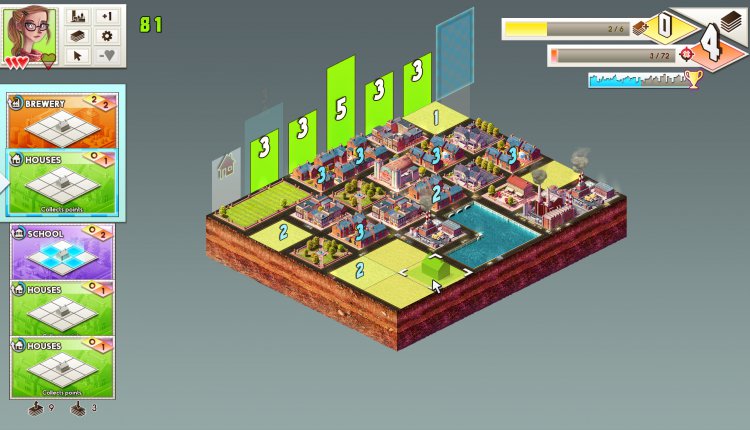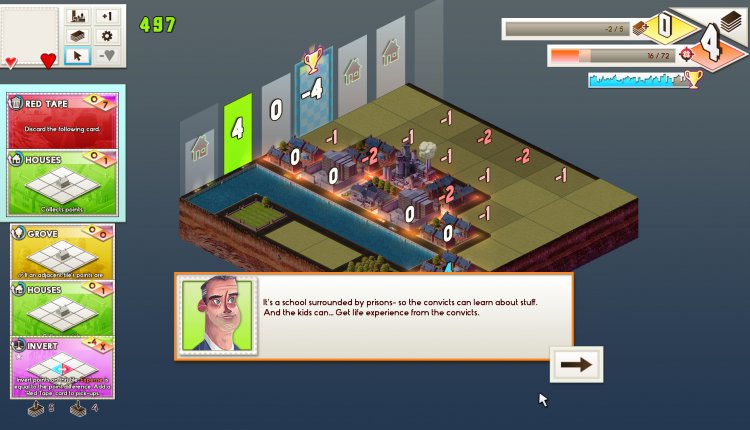Puzzle your way to city-planning success in Concrete Jungle
Deck-building in City Hall
Like any city worth visiting, Concrete Jungle is jam packed with things to do and see. There’s a lot to take in, so much that it’s going to take more than a few trips to wrap your head around how it all fits together. At its core, this is a puzzle game constructed around deck-building, set on a grid and using urban planning as an overall theme to tie all of its elements together.
Concrete Jungle has a freeplay mode, a campaign with a story and full voice acting. There’s also a vs. mode, and multiple unlockable characters each with their own city planning proclivities and cards. It’s like a metropolis with layers upon layers of buildings and infrastructure. Or, like a jungle of dense vegetation and wildlife. So put on your hardhat, take up a machete, grab whichever metaphor you prefer, and lets run through the basics.
Everything happens on the grid, which is made up of square plots: each possible sites where you can choose to place a building. Each column of the grid collects positive or negative points and these points are displayed at the far end of the column. The goal is to collect the required number of points in each column. Doing this allows the column to be cleared and the resulting points to be added to your score, but the columns are only cleared left to right and can only be cleared in that order. Columns collect points independently of one another, but if you are able to clear multiple columns in a row, sequencing your building choices so that the points-to-clear goal is reached on the first column last, you collect bonus points and can watch in glee as the whole grid clears one column after the other.
But how do you collect points? And what determines the column’s points-to-clear number?
This is where the deck element comes in. The player is shown five cards from their deck at all times and on a turn is given the opportunity to play one of the first two. The cards are possible buildings to be placed, for example, a supermarket, or shops, or houses. Each card shows the building sitting on its own 3×3 grid. This grid shows the impact the structure will have on spaces around it.

A supermarket adds a point to three squares in the column in front of it and adds a negative point to the three squares in the column behind it, while a shop just adds one point to the square directly in front of it. In the beginning only houses collect points. Squares have a zero-point value until a structure is added that increases or decreases their value. Plop a house down on a square where you have added points by previously placing a structure and those points are added to the column’s total.
So that explains how to collect points but what about the points-to-clear number?
To explain how that is set you have to understand the distinction Concrete Jungle makes between economy and expense. Every card has two numbers in the top right-hand corner. The first number is the economy number. Every economy point spent is counted in a bar on the top right-hand corner of the game screen and goes towards points to buy new cards or skills. The second number is expense number and this is also counted in a bar. The expense number is what determines the points-to-clear number needed to clear a column. Spend beyond the given expense number and the points-to-clear number rises, complicating your task as a puzzle-solving, city builder extraordinaire.

If this sounds like a lot, well, it is. And remember, we’re just strolling through the basics here. Concrete Jungle is dense and can feel like several games compressed together, but compressed in such a way that the complexity and spark of each idea is still preserved. For example, I’ve glossed over the skill trees, which are available for each character and are determined by the character’s personalities. Characters are unlocked in story mode and feature a young, plucky idealist; a mayor flying by the seat of his pants; an anarchist farmer, and more. Each character has different building cards and skills available to it. I haven’t even tried to explain Vs. mode here, where players can play against each other or against an AI. This mode features completely different rules and requires learning new strategies. And don’t forget that the game features more than 200 different types of cards.
But what stands out to me more than the complexity of the rules and the variety of modes is the high quality and polish on this game. It’s very pleasing to look at. It has fantastic, chill music. The voice acting is very well done and entertaining. The game even has a day-to-night cycle that runs with different weather patterns to prevent the static view of the grid from becoming stale. The overall design and amount of wit and charm here is remarkable, especially given its extensive replay-value and very reasonable price tag.
If you decide to pick it up, just be aware that it can be very challenging. I recommend playing with a strong cup of coffee, or your favorite stimulant of choice. As charming and colorful as it looks, the difficulty is high, and while there is a tutorial, you’re left to figure out a lot of things for yourself. I recommend it to anyone who enjoys challenging puzzle games or deck-builders. If you enjoyed, for example, Islanders earlier this year, but wanted more of a lasting challenge Concrete Jungle is waiting for you.
Comments are closed.